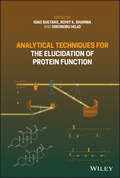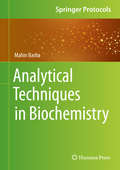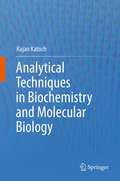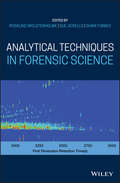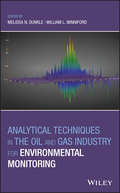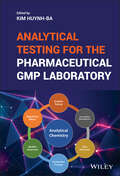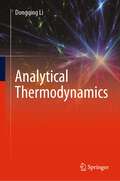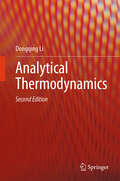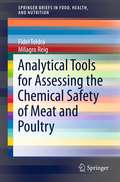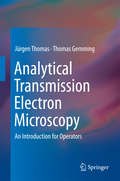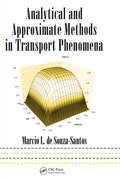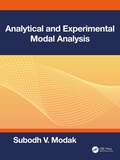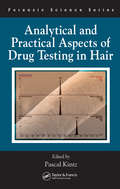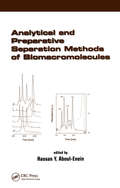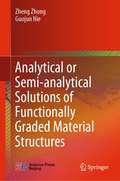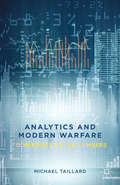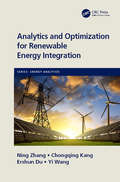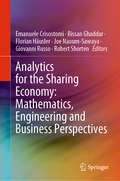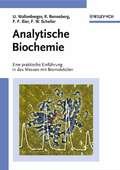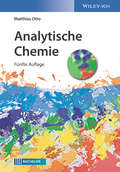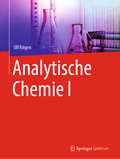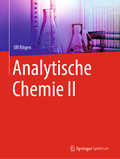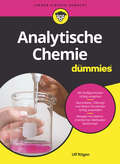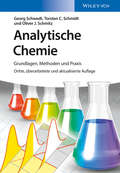- Table View
- List View
Analytical Techniques for the Elucidation of Protein Function
by Isao Suetake Rohit K. Sharma Hironobu HojoANALYTICAL TECHNIQUES FOR THE ELUCIDATION OF PROTEIN FUNCTION An essential aid for scientists seeking alternative techniques for investigating proteins Proteins are the building blocks of living organisms, and they play an enormous range of fundamental roles in sustaining and shaping life. The critical determinant of a protein’s function is its structure, and the analysis of protein structures has therefore become a significant component of biological research. In recent years, longstanding analytical techniques such as X-ray crystallography and nuclear magnetic resonance (NMR) spectroscopy have been supplemented by a number of new methods which promise to revolutionize the study of proteins and their functions. Analytical Techniques for the Elucidation of Protein Function serves as an introduction to these techniques, which are especially crucial for analyzing intrinsically disordered regions and post-translational modifications. These have revolutionized the study of proteins in recent years, and conventional methods for analyzing protein structures are no longer sufficient to work through their ramifications. This book therefore brings greater awareness of techniques which promise to produce the very cutting edge of protein research. Analytical Techniques for the Elucidation of Protein Function readers will find: A discussion of techniques including electron paramagnetic resonance (ESR) spectroscopy, neutron scattering, Raman imaging, and more Both theoretical background and practical applications for each technique Contributions from leading international researchers into protein structure and function This practically focused text is a valuable reference for protein and peptide analysis and synthesis researchers, as well as for graduate and advanced undergraduate students in the life sciences.
Analytical Techniques in Biochemistry (Springer Protocols Handbooks)
by Mahin BashaThis book provides a comprehensive overview of the major biochemical analytical techniques, with detailed descriptions of the instrumentation and applications. The contributions, which each focus on a specific technique, are based on a thorough review and analysis of the current literature as well as the authors’ experiences in the lab. Divided into nine parts, the book provides insights into basic separation techniques like sedimentation, filtration and centrifugation, as well as analytical techniques such as spectrophotometry, chromatography, electrophoresis, immuno-techniques, radioactivity and microscopy.
Analytical Techniques in Biochemistry and Molecular Biology
by Rajan KatochAdvances in biochemistry now allow us to control living systems in ways that were undreamt of a decade ago. This volume guides researchers and students through the full spectrum of experimental protocols used in biochemistry, plant biology and biotechnology.
Analytical Techniques in Forensic Science
by Rosalind WolstenholmeAn in-depth text that explores the interface between analytical chemistry and trace evidence Analytical Techniques in Forensic Science is a comprehensive guide written in accessible terms that examines the interface between analytical chemistry and trace evidence in forensic science. With contributions from noted experts on the topic, the text features a detailed introduction analysis in forensic science and then subsequent chapters explore the laboratory techniques grouped by shared operating principles. For each technique, the authors incorporate specific theory, application to forensic analytics, interpretation, forensic specific developments, and illustrative case studies. Forensic techniques covered include UV-Vis and vibrational spectroscopy, mass spectrometry and gas and liquid chromatography. The applications reviewed include evidence types such as fibers, paint, drugs and explosives. The authors highlight data collection, subsequent analysis, what information has been obtained and what this means in the context of a case. The text shows how analytical chemistry and trace evidence can problem solve the nature of much of forensic analysis. This important text: Puts the focus on trace evidence and analytical science Contains case studies that illustrate theory in practice Includes contributions from experts on the topics of instrumentation, theory, and case examples Explores novel and future applications for analytical techniques Written for undergraduate and graduate students in forensic chemistry and forensic practitioners and researchers, Analytical Techniques in Forensic Science offers a text that bridges the gap between introductory textbooks and professional level literature.
Analytical Techniques in the Oil and Gas Industry for Environmental Monitoring
by Melissa N. Dunkle William L. WinnifordA thorough introduction to environmental monitoring in the oil and gas industry Analytical Techniques in the Oil and Gas Industry for Environmental Monitoring examines the analytical side of the oil and gas industry as it also provides an overall introduction to the industry. You’ll discover how oil and natural gas are sourced, refined, and processed. You can learn about what’s produced from oil and natural gas, and why evaluating these sourced resources is important. The book discusses the conventional analyses for oil and natural gas feeds, along with their limitations. It offers detailed descriptions of advanced analytical techniques that are commercially available, plus explanations of gas and oil industry equipment and instrumentation. You’ll find technique descriptions supplemented with a list of references as well as with real-life application examples. With this book as a reference, you can prepare to apply specific analytical methods in your organization’s lab environment. Analytical Techniques can also serve as your comprehensive resource on key techniques in the characterization of oil and gas samples, within both refinery and environmental contexts. Understand of the scope of oil and gas industry techniques available Consider the benefits and limitations of each available process Prepare for applying analytical techniques in your lab See real examples and a list of references for each technique Read descriptions of off-line analytics, as well as on-line and process applications As a chemist, engineer, instructor, or student, this book will also expand your awareness of the role these techniques have in environmental monitoring and environmental impact assessments.
Analytical Testing for the Pharmaceutical GMP Laboratory
by Kim Huynh-BaProvides practical guidance on pharmaceutical analysis, written by leading experts with extensive industry experience Analytical Testing for the Pharmaceutical GMP Laboratory presents a thorough overview of the pharmaceutical regulations, working processes, and drug development best practices used to maintain the quality and integrity of medicines. With a focus on smaller molecular weight drug substances and products, the book provides the knowledge necessary for establishing the pharmaceutical laboratory to support Quality Systems while maintaining compliance with Good Manufacturing Practices (GMP) regulations. Concise yet comprehensive chapters contain up-to-date coverage of drug regulations, pharmaceutical analysis methodologies, control strategies, testing development and validation, method transfer, electronic data documentation, and more. Each chapter includes a table of contents, definitions of acronyms, a reference list, and ample tables and figures. Addressing the principal activities and regulatory challenges of analytical testing in the development and manufacturing of pharmaceutical drug products, this authoritative resource: Describes the structure, roles, core guidelines, and GMP regulations of the FDA and ICH. Covers the common analytical technologies used in pharmaceutical laboratories, including examples of analytical techniques used for the release and stability testing of drugs. Examines control strategies established from quality systems supported by real-world case studies. Explains the use of dissolution testing for products such as extended-release capsules, aerosols, and inhalers. Discusses good documentation and data reporting practices, stability programs, and the Laboratory Information Management System (LIMS) to maintain compliance. Includes calculations, application examples, and illustrations to assist readers in day-to-day laboratory operations. Contains practical information and templates to structure internal processes or common Standard Operating Procedures (SOPs). Analytical Testing for the Pharmaceutical GMP Laboratory is a must-have reference for both early-career and experienced pharmaceutical scientists, analytical chemists, pharmacists, and quality control professionals. It is also both a resource for GMP laboratory training programs and an excellent textbook for undergraduate and graduate courses of analytical chemistry in pharmaceutical sciences or regulatory compliance programs.
Analytical Thermodynamics
by Dongqing LiThis book provides the foundations of analytical thermodynamics for graduate level. The content is based on the author’s lecture notes developed over 30 years of academic teaching. It aims to present thermodynamics to the readers as easy to understand as possible, being suitable for professors teaching advanced thermodynamics or graduate students learning thermodynamics. The chapters include the basics of analytical thermodynamics, modelling of homogeneous and heterogeneous systems, thermodynamics of interfaces and three-phase contact lines and the Second Law in engineering thermodynamics.
Analytical Thermodynamics
by Dongqing LiThis second edition presents an enriched and expanded exploration of the fundamental principles of thermodynamics tailored for graduate-level studies. Drawing on over three decades of academic teaching experience, the author has refined the content, making it more accessible and comprehensive. Chapter 1 has been restructured for clarity, delineating "Legendre Transformation" and "Thermodynamic Potentials" into separate sections, while the treatment of "Chemical Potentials" has been significantly augmented, encompassing two-component ideal gas mixtures and a re-derivation of chemical potentials for dilute solutions. Additionally, the section on thermodynamic stability now boasts enhanced explanations and illustrative figures. Chapter 2 introduces a groundbreaking section, "Electrolyte Solution in Electric Field as a Non-Uniform System," providing fresh insights into unexplored realms. Chapter 3, now enriched with several new sections, delves into topics such as "Contact Angles on Heterogeneous Surfaces and Rough Surfaces," "Elastic Liquid-Fluid Interface," "Curvature Effect on Surface Tension," "Solute Effect on Equilibrium Pressure," and "Heterogeneous Bubble Nucleation in a Dilute Solution." Chapter 4 features new elucidations and discussions aimed at bolstering comprehension, while the entirely new Chapter 5 offers solutions to selected homework and exam questions, adding a practical dimension to the theoretical framework. This edition, encompassing approximately 50% new content, expands the book by 131 pages, rendering it an even more invaluable resource for professors instructing advanced thermodynamics and graduate students delving into this intricate subject matter.
Analytical Tools for Assessing the Chemical Safety of Meat and Poultry (SpringerBriefs in Food, Health, and Nutrition #9)
by Fidel Toldrá Milagro ReigThe goal of the Brief is to summarize the state of the art on the chemical safety issues currently concerning meat and poultry, and to discuss the current international legislation on the tools available for their control. The Brief will review the analytical controls and instrumentation available for the control of residues of growth promoters, antibiotics, and any other environmental substances in raw meat and poultry. In addition, there will be a discussion of both the substances that may be generated as a consequence of processing, and the tools that are available for their control. These substances may be quite varied in nature; they may include, for example, the heterocyclic amines generated by heating, the nitrosamines sometimes present in cured meats with nitrite if not properly processed, the polycyclic aromatic hydrocarbons that can be generated depending on the type of smoking used, or the biogenic amines that can be generated during fermentation. Finally, the controls for the detection of foreign proteins (e.g., whey proteins) in the final products will be also compiled. The Brief will conclude with a view of future trends and key references for readers interested in learning more about this topic.
Analytical Transmission Electron Microscopy: An Introduction for Operators
by Jürgen Thomas Thomas GemmingThis work is based on experiences acquired by the authors regarding often asked questions and problems during manifold education of beginners in analytical transmission electron microscopy. These experiences are summarised illustratively in this textbook. Explanations based on simple models and hints for the practical work are the focal points. This practically- oriented textbook represents a clear and comprehensible introduction for all persons who want to use a transmission electron microscope in practice but who are not specially qualified electron microscopists up to now.
Analytical and Approximate Methods for Complex Dynamical Systems (Understanding Complex Systems)
by Alexander TimokhaThis book presents Analytical and Approximate Methods for Complex Dynamical Systems and introduces ideas of discontinuous mapping treated as complex dynamical systems. Mathematicians of world-recognized Ukrainian scientific schools established by M.Krylov, M.Bogolyubov, Yu.Mitropolskiy, and A.Sharkovsky used to cooperate for writing the collective book whose purpose consists of illustrating a synergy of combining diverse (by idea and technique) constructive analytical and approximate approaches and methods in complex dynamical systems which are herein associated with mathematical models of networks, conflict/economic theories, sloshing, soft matter, and even levitating drops. Readers are facilitated to learn contemporary insights, fundamentals (Parts I and III), applications (Part II), and components of theories of bifurcation, synchronization/self-organization, collective dynamics, chaos, solitons, fractional differential equations, symmetry, reduced order modelling, and many others, that makes the book useful for both graduate and postgraduate students, lecturers, researchers, and even engineers dealing with multidimensional dynamic systems.
Analytical and Approximate Methods in Transport Phenomena
by Marcio L. de Souza-SantosOn the job or in the field, when facing a problem with differential equations and boundary conditions, most likely you don't have time to read through several publications in search of a method that may or may not solve your problem. Organized for quick and easy access to practical solutions, Analytical and Approximate Methods in Transport Pheno
Analytical and Experimental Modal Analysis
by Subodh V. ModakThis book covers the fundamentals and basic concepts of analytical and experimental approaches to modal analysis. In practice, the analytical approach based on lumped parameter and finite element models is widely used for modal analysis and simulation, and experimental modal analysis is widely used for modal identification and model validation. This book is inspired by this consideration and is written to give a complete picture of modal analysis. Features: Presents a systematic development of the relevant concepts and methods of the analytical and experimental modal analyses. Covers phase resonance testing and operational modal analysis. Provides the relevant signal processing concepts. Includes applications like model validation and updating, force identification and structural modification. Contains simulations, examples, and MATLAB® programs to enhance understanding. This book is aimed at senior undergraduates/graduates, researchers, and engineers from mechanical, aerospace, automotive, civil, and structural engineering disciplines.
Analytical and Practical Aspects of Drug Testing in Hair (International Forensic Science and Investigation)
by Pascal KintzWritten by well-known, international authors, this comprehensive reference provides practical coverage of the best hair drug testing techniques and examines the drugs themselves. The authors review all new developments, the validation of analytical procedures, and the interpretation of data. Some of the applications discussed include doping, drug-facilitated crime investigating, workplace testing, and the granting of drivers' licenses. The authors describe specific drugs, such as opiates, cocaine, and cannabis, and discuss the different testing methods of them. The book also covers postmortem toxicology, pitfalls created by passive exposure, and testing for metals, including inductively coupled plasma spectrometry (ICP-MS), hair multielemen
Analytical and Preparative Separation Methods of Biomacromolecules
by Hassan Y. Aboul-EneinReports up-to-date research developments on purifying and isolation large organic molecules. The text provides information on high-performance liquid chromatography and capillary electrophoresis (CE) as tools for analyzing biomacromolecules and developing new biochemical and medicinal compounds. It applies biochemical separation technology to the study of macromolecules such as proteins, polysaccharides, nucleic acids and more.
Analytical or Semi-analytical Solutions of Functionally Graded Material Structures
by Zheng Zhong Guojun NieThis book provides a comprehensive introduction to the analysis of functionally graded materials and structures. Functionally graded materials (FGMs), in which the volume fractions of two or more constituent materials are designed to vary continuously as a function of position along certain direction(s), have been developed and studied over the past three decades. The major advantage of FGMs is that no distinct internal boundaries exist, and failures from interfacial stress concentrations developed in conventional components can be avoided. The gradual change of material properties can be tailored to different applications and working environments. As these materials’ range of application expands, new methodologies have to be developed to characterize them, and to design and analyze structural components made of them.Despite a number of existing papers on the analysis of functionally graded materials and structures, there is no single book that is devoted entirely to the analysis of functionally graded beams, plates and shells using different methods, e.g.,analytical or semi-analytical methods.Filling this gap in the literature, the book offers a valuable reference resource for senior undergraduates, graduate students, researchers, and engineers in this field. The results presented here can be used as a benchmark for checking the validity and accuracy of other numerical solutions. They can also be used directly in the design of functionally graded materials and structures.
Analytics And Modern Warfare: Dominance by the Numbers
by Michael TaillardThis book details very simply and for even the most novice of potential analysts not only how to perform analytics which describe what is happening, predict what is going to happen, and optimize responses, but also places these analytics in the context of proactive strategy development.
Analytics and Optimization for Renewable Energy Integration (Energy Analytics)
by Ning Zhang Yi Wang Chongqing Kang Ershun DuThe scope of this book covers the modeling and forecast of renewable energy and operation and planning of power system with renewable energy integration.The first part presents mathematical theories of stochastic mathematics; the second presents modeling and analytic techniques for renewable energy generation; the third provides solutions on how to handle the uncertainty of renewable energy in power system operation. It includes advanced stochastic unit commitment models to acquire the optimal generation schedule under uncertainty, efficient algorithms to calculate the probabilistic power, and an efficient operation strategy for renewable power plants participating in electricity markets.
Analytics for the Sharing Economy: Mathematics, Engineering and Business Perspectives
by Giovanni Russo Emanuele Crisostomi Robert Shorten Bissan Ghaddar Florian Häusler Joe Naoum-SawayaThe book provides an encompassing overview of all aspects relating to the sharing economy paradigm in different fields of study, and shows the ongoing research efforts in filling previously identified gaps in understanding in this area. Control and optimization analytics for the sharing economy explores bespoke analytics, tools, and business models that can be used to help design collaborative consumption services (the shared economy). It provides case studies of collaborative consumption in the areas of energy and mobility.The contributors review successful examples of sharing systems, and explore the theory for designing effective and stable shared-economy models. They discuss recent innovations in and uses of shared economy models in niche areas, such as energy and mobility. Readers learn the scientific challenging issues associated with the realization of a sharing economy. Conceptual and practical matters are examined, and the state-of-the-art tools and techniques to address such applications are explained. The contributors also show readers how topical problems in engineering, such as energy consumption in power grids, or bike sharing in transportation networks, can be formulated and solved from a general collaborative consumption perspective. Since the book takes a mathematical perspective to the topic, researchers in business, computer science, optimization and control find it useful. Practitioners also use the book as a point of reference, as it explores and investigates the analytics behind economy sharing.
Analytische Biochemie: Eine praktische Einfuhrung in das Messen mit Biomolekulen
by Frank F. Bier Ulla Wollenberger Reinhard Renneberg Frieder W. SchellerZur Lösung analytischer Fragestellungen wird in der Biotechnologie, der Lebensmittel- und Umweltanalytik sowie der klinischen und pharmazeutischen Chemie neben der instrumentellen Analytik immer häufiger auf bioanalytische Methoden zurückgegriffen. Diese beruhen z. B. auf dem Einsatz von Enzymen, Nukleinsäuren oder Antikörpern. Dazu bietet das Buch eine praktische Einführung in die qualitative und quantitative Analytik mit biochemischen Reagenzien, die sowohl für das Studium wie für die Weiterbildung im Beruf geeignet ist. Die Autoren schlagen eine Brücke von den theoretischen Grundlagen hin zu den praktischen Anwendungen. Dem vertieften Verständnis dient die Beschreibung erprobter Praktikumsversuche. Die Autoren gehören zu einer der weltweit führenden Forschungsgruppen auf diesem Gebiet, lassen aber auch ihre langjährige Lehrerfahrung in dieses neue Buch einfließen.
Analytische Chemie
by Matthias OttoDer "Otto" hat sich zu einem Standardwerk für Studenten der Chemie, Pharmazie, Lebensmittelchemie und anderer chemischer Disziplinen entwickelt, das auch von Nicht-Chemikern und Chemieingenieuren wegen seines didaktischen Aufbaus und seiner klaren Darstellung geschätzt wird. In fünfter, nochmals aktualisierter und um neueste Analysemethoden ergänzter Auflage, wird das gesamte Analytik-Wissen auf Bachelor-Niveau dargestellt. Mit dem Blick für das Wesentliche erklärt der Autor, worauf es bei den vielen heute gebräuchlichen Analysemethoden wirklich ankommt. Von den Grundlagen der qualitativen und quantitativen Analyse bis zu modernen Hochdurchsatz-Analysegeräten und der Qualitätssicherung wird die gesamte Bandbreite der modernen Analytik vorgestellt. Die fünfte Auflage bietet noch mehr Aufgaben und Lösungen zur Selbstkontrolle, außerdem zahlreiche Beispielrechnungen. Die Begriffe und Konstanten sind nach harmonisierten IUPAC-Definitionen aktualisiert. Eine blaue Schmuckfarbe wird im Buch verwendet, um einen noch effizienteren Lernprozess zu ermöglichen.
Analytische Chemie I
by Ulf RitgenDas Arbeitsbuch führt durch das erfolgreiche Werk Harris, Lehrbuch der Quantitativen Analyse und ist vor allem für das Selbststudium konzipiert. In fünf Teilen werden die Vorlesungsinhalte der Analytischen Chemie zusammengefasst und anhand ausgewählter Beispiele erläutert. Grundbegriffe der Analytik werden ebenso dargelegt wie das Prinzip und die verschiedenen Techniken der Maßanalyse und der Chromatographie. Anhand von UV/VIS-, Infrarot- und Raman-Spektroskopie wird die Untersuchung molekular vorliegender Verbindungen erklärt, mit ausgewählten Techniken der Atomspektroskopie findet die Einführung in die Grundlagen der Analytik ihren Abschluss. Dabei wird immer wieder auf essenzielle Abschnitte und Abbildungen des Lehrbuches verwiesen, was das selbstständige Lernen der Grundlagen der Analytischen Chemie erleichtert.Leicht lesbar führt das Buch in die Grundlagen und die wichtigsten Techniken der Analytischen Chemie ein; es richtet sich an Studierende im Grundstudium der Chemie oder verwandter naturwissenschaftlicher Fächer. Dabei wird immer wieder auf die aus Lehrveranstaltungen der Allgemeinen Chemie bekannten Grundlagen Rückbezug genommen, sodass die Zusammenhänge zwischen bereits Bekanntem und Neuem sofort erkenntlich werden. Das Lernen mit diesem Arbeitsbuch ist in einem Fernstudiengang Chemie erprobt und erleichtert die Vorbereitung auf Modulprüfungen der Analytischen Chemie.
Analytische Chemie II
by Ulf RitgenDieses Arbeitsbuch führt durch das erfolgreiche Lehrbuch Skoog/Holler/Crouch, Instrumentelle Analytik und ist vor allem für das Selbststudium konzipiert.In fünf Teilen werden die Vorlesungsinhalte der fortgeschritteneren Analytischen Chemie zusammengefasst und anhand ausgewählter Beispiele erläutert: Mit der Untersuchung von Molekülen befassen sich Massenspektrometrie und Kernresonanzspektroskopie, zudem werden zahlreiche elektroanalytische Methoden wie Potentiometrie, Coulometrie, Amperometrie und Voltammetrie behandelt. In einem Überblick über speziellere Verfahren der Analytik geht es unter anderem ebenso um den Einsatz radioaktiver Substanzen und die Nutzung verschiedener Fluoreszenzverfahren wie um Methoden der Informationsgewinnung in der zunehmend wichtigen elektrochemischen und optischen Sensortechnik sowie deren Automatisierbarkeit. Den Abschluss bildet eine Zusammenfassung verschiedener Prinzipien und Anwendungsmethoden der Statistik, die im Rahmen der Analytik schlichtweg unverzichtbar sind. Um das selbstständige Lernen zu erleichtern, wird dabei in allen Teilen des Buches immer wieder auf essenzielle Abschnitte und Abbildungen des Lehrbuches verwiesen.Nicht zuletzt aufgrund der zahlreichen Beispiele führt das Buch, das sich an Studierende der Chemie oder verwandter naturwissenschaftlicher Fächer richtet, leicht nachvollziehbar auch in komplexere Aspekte der Analytischen Chemie ein. Dabei wird in direkter Fortführung des Arbeitsbuches Analytische Chemie I immer wieder auf bereits bekannte Grundlagen aus anderen Lehrveranstaltungen verwiesen, die das Verknüpfen von Vertrautem und Neuem erleichtern. Das Lernen mit diesem Arbeitsbuch ist in einem Fernstudiengang Chemie erprobt und erleichtert die Vorbereitung auf Modulprüfungen der fortgeschritteneren Analytischen Chemie.
Analytische Chemie für Dummies (Für Dummies)
by Ulf RitgenDie Analytik ist zwar ein grundlegendes Thema innerhalb der Chemie, hat es aber ganz schön in sich. Aber keine Sorge, Ulf Ritgen erklärt Ihnen in diesem Buch was Sie zur Analytischen Chemie Wissen sollten. Wie erhält man eigentlich analytische Infos? Welche Standards gibt es? Und wie sollte man überhaupt mit den Stoffgemischen umgehen? All diese Grundlagen werden ausführlich erläutert. Aber auch die Anwendungsgebiete und Methoden kommen keinesfalls zu kurz. Egal ob Gravimetrie, Titration, Fällung oder Konduktometrie, endlich wird alles verständlich erklärt. Jetzt können Prüfung und Praktikum kommen!
Analytische Chemie: Grundlagen, Methoden und Praxis
by Georg Schwedt Oliver J. Schmitz Torsten C. SchmidtAlle relevanten Aspekte der Analytischen Chemie werden in diesem Lehrbuch, das gleichzeitig auch als Referenz fur Praktiker dient, umfassend und klar auf den Punkt gebracht. Das Autorenteam wird durch zwei aktive und international bekannte Professoren verstarkt; dies sorgt fur frischen Wind, gleichzeitig wird der didaktisch ausgefeilte Stil der Vorauflagen beibehalten. Von der Analysenstrategie zur Probenvorbereitung, von der Ma?analyse uber spektroskopische und chromatographische Methoden bis zur Automatisierung - DAS Lehrbuch fur alle, die sich mit Analytischer Chemie beschaftigen.
